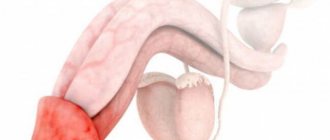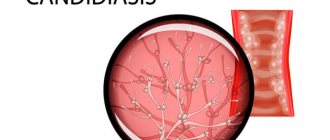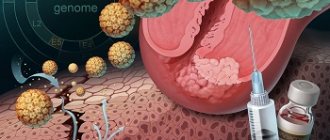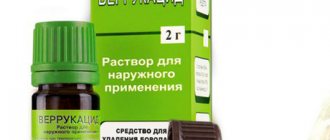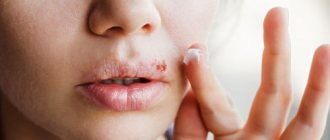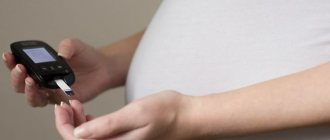What does the disease look like in newborns?
At the beginning of the disease, the baby develops areas of redness and abrasion of the skin in the groin and genital area. This is the so-called diaper rash, which progresses and spreads without treatment. Large red spots merge into large areas of irritation, skin blisters, crusts, peeling, and small erosions appear. At an advanced stage, bubbles form with a cloudy liquid inside them. This indicates that a fungus or staphylococcus has joined. Source: G.S. Koval Prevention and treatment of diaper dermatitis // Issues of modern pediatrics, 2004, vol. 3, no. 5, pp. 60-64
In addition, there are subtypes of dermatitis. When a baby constantly spits up, stomach contents get into the skin folds of his neck, causing irritation. Also, sometimes the process is isolated by the inguinal folds, anus, and genitals.
To identify the type and stage of inflammation, you need to consult a pediatrician. Based on external signs, the doctor will determine why the disease appeared and how to treat the child. If the process develops and cannot be treated, more detailed diagnostics are needed. It involves taking a smear from the affected area to determine the microflora.
Causes of thrush in a child
Because the child’s immunity is still too weak and this contributes to the development of favorable conditions for the development of candidiasis (candida fungi are the first of the microscopic fungi that a child encounters at birth).
In the first week of life, so-called thrush (damage to the mucous membranes of the oral cavity) may develop in the form of a cheesy white coating on the inner surface of the neck, tongue and gums. Basically, this process is temporary and goes away during the first month of life, and with a weakened immune system, thrush can be recurrent and difficult to treat. In addition, if the skin is damaged, the process can spread to natural folds and in the area of diaper rash. Healthy skin can resist the effects of fungi on its own, but damaged skin cannot do this, and a fungal infection can become more severe. Breastfeeding plays an important role because breast milk helps repopulate the sterile intestines with beneficial microorganisms. Therefore, the body of bottle-fed children is more susceptible to infection entering the body.
The process of fungal development is aggravated by wearing diapers, which create a “greenhouse effect” and due to the warm, humid environment, fungal infections multiply quickly. A healthy breastfed baby cannot develop candidiasis. If thrush appears again after treatment, this should be assessed as a signal that the immune system is weakened. In children, candidiasis can either be temporary or become a serious disease requiring treatment from a specialist.
Recurring oral thrush in infants can cause damage to the fingernails. This occurs in infants who prefer their finger to the pacifier. As a result of the lesion, the nail plate becomes deformed, thickens, the periungual fold turns red and a white mass is released from under it.
In girls, candidiasis can develop into candidal vulvitis, and in boys, balanoposthitis can occur (redness and a white cheesy coating appear in the area of the urethral opening). These phenomena may not bother the child, but are sometimes accompanied by itching, burning and pain.
In older children, Candida fungi can cause allergic diseases, which, in turn, affect the skin, mucous membranes and intestines. Therefore, children with allergic diseases should undergo a comprehensive examination, including for possible candidiasis.
How to cure?
Important! Parents should pay maximum attention to prevention and take action at the first sign to prevent the spread of inflammation.
Diaper dermatitis occurs on different parts of the body
, depending on the factor that provoked it. The severity of symptoms also varies.
The baby's skin in the diaper wearing area should always be clean and dry. To prevent increased humidity, you need to change the diaper often and use modern products that have a special gel in the absorbent layer and soft cellulose material in contact with the skin. They not only quickly absorb urine, but also retain it inside, preventing harmful skin contact with moisture. The diaper must be selected strictly in size and fastened well with fasteners. In addition, it is recommended to dress the child according to the weather, avoid overheating, and do not wear tight clothes or things made of synthetic materials. Source: D.Sh. Macharadze, Doctor of Medical Sciences, Professor Features of differential diagnosis and treatment in children // Medical Council, 2012, No. 2, pp. 77-82
If the disease is noticed at the earliest stage of development, then simple steps are sufficient to eliminate it:
- You need to change the diaper often and let the baby's skin breathe. Maximum contact with air is the safest and most reliable treatment method. If the room is warm, then the child can even be left to sleep with his lower body exposed.
- When changing a diaper, the skin should be cleaned, lubricated with special creams or powdered with powder. Avoid over-powdering, which will cause the powder to crumble.
- areas of the skin affected by dermatitis are treated with baby ointments. For example, “Desitin”, which contains zinc oxide. Ointments "Bepanten" and "Depanthenol" have an anti-inflammatory effect.
- if candidiasis is involved, then all measures are aimed at eliminating it; powders with antifungal action are used.
- It is also recommended to use low-alkaline baby soap no more than once a day.
Some forms of the disease require the use of local steroids, antiviral, and antibacterial agents. Parents should definitely contact a dermatologist to prescribe the correct treatment.
Sources:
- G.S. Koval. Prevention and treatment of diaper dermatitis // Issues of modern pediatrics, 2004, vol. 3, no. 5, pp. 60-64.
- D.Sh. Macharadze, Doctor of Medical Sciences, Professor. Features of differential diagnosis and treatment in children // Medical Council, 2012, No. 2, pp. 77-82.
The information in this article is provided for reference purposes and does not replace advice from a qualified professional. Don't self-medicate! At the first signs of illness, you should consult a doctor.
Treatment of atopic dermatitis in children
In this article, we will pay great attention to the treatment of this disease, and will also talk about the main features of the use of medications in children with atopic dermatitis.
The basis of treatment is external therapy using various medications. The goal of external (local) therapy is the complete elimination of inflammatory changes, itching, as well as restoration of the water-lipid layer of the skin. Local glucocorticosteroids (hormones), calcineurin inhibitors, and emollients are used as such agents. We will pay special attention to emollients. Emollients are medicinal cosmetics that care for the skin and prevent dry skin. In some cases, systemic therapy is also prescribed. Systemic therapy refers to the use of drugs that are administered orally. Antihistamines are most often used as systemic therapy.
Below we consider the most common drugs for the treatment of blood pressure in children.
The goal of local therapy for atopic dermatitis is the complete elimination of inflammatory changes and itching.
Hormones
Local glucocorticosteroids (MGS) are used as hormones. They are the most powerful drugs at the onset of the disease, which allows the symptoms of this disease to be eliminated in the shortest possible time. The duration of use of these drugs should not exceed two weeks. If possible, use of MGCs should be short.
What parents should remember when using these products:
- It is not recommended to mix MHA with other agents.
- When the symptoms of the disease decrease, it is necessary to reduce the amount and frequency of MHA use.
- In the event of a bacterial or fungal infection, it is necessary to use a combination of MHA with antibacterial and antifungal drugs.
- Do not apply these medications under closed dressings.
- With long-term use, complications may develop. Such complications include: stretch marks, telangiectasia, skin atrophy. Striae are white to pink stripes on the skin. Telangiectasia is popularly called “spider veins”. This complication is a vascular formation with dilated vessels. Atrophy is characterized by a skin defect with a change in its volume and elastic properties.
Local hormones exist in different classes, depending on the strength of their action. The most common MGCs are: celestoderm, elokom, lokoid, dermovate, cutivate.
Calcineurin inhibitors (CI)
A special feature of these drugs is the absence of complications inherent to hormones. They can be used together with hormones. After eliminating symptoms, MGC can be replaced with IR, which will avoid the development of complications. The two most common medications in this group are pimecrolimus and tacrolimus. Pimecrolimus is used for mild cases, while tacrolimus is used for severe cases.
Prices
| Name of service (price list incomplete) | Price |
| Appointment (examination, consultation) with a dermatovenerologist, primary, therapeutic and diagnostic, outpatient | 1950 rub. |
| Consultation (interpretation) with analyzes from third parties | 2250 rub. |
| Prescription of treatment regimen (for up to 1 month) | 1800 rub. |
| Prescription of treatment regimen (for a period of 1 month) | 2700 rub. |
| Consultation with a candidate of medical sciences | 2500 rub. |
| Dermatoscopy 1 element | 700 rub. |
| Setting up functional tests | 190 rub. |
| Excision/removal of cutaneous/subcutaneous elements and formations (1 element) | 2550 rub. |
| Removal of milia of one unit using electrocoagulation | 350 rub. |
- Gallery
- Reviews
- Articles
- Licenses
- Vacancies
- Insurance partners
- Partners
- Controlling organizations
- Schedule for receiving citizens for personal requests
- Online consultation with a doctor
- Documentation
Diaper rash is an inflammation of the skin, mainly in the area of folds, which occurs due to friction (mechanical irritation) of contacting surfaces. This is accompanied by the action of sweat and irritation of the skin by feces and urine.
Later, in areas of inflammation, opportunistic flora (i.e., microorganisms that normally live on our skin without causing disease) may become active:
- yeast-like fungi of the genus Candida;
- staphylococci;
- streptococci and many others.
Most often, diaper dermatitis occurs when:
- prolonged stay of the child in diapers;
- rarely changing diapers;
- poor nutrition;
- stool disorders.
Diaper rash most often develops in the inguinal and intergluteal folds. The following appear on the affected areas :
- redness;
- surface cracks;
- there may be a little weeping.
Diaper rash can cause inconvenience to the baby - it can be accompanied by itching, and when cracks appear, pain. Most cases of fold lesions can be attributed to candidiasis.
In this case, as a rule, the following are noted:
- more pronounced swelling;
- redness;
- weeping phenomena;
- cracks;
- erosion;
- covered with a grayish or whitish coating;
- there may be an unpleasant odor.
Candidiasis can also develop on healthy skin in the absence of diaper rash, for example, when taking antibiotics, when intestinal dysbiosis occurs, or in immunodeficiency conditions in a child. It should be clarified that candidiasis can affect not only the skin and mucous membranes, but also internal organs. In this case, in order to get rid of the manifestations on the skin, it is necessary to treat the intestines and other internal foci of candidiasis.
If you do not seek medical help from a doctor in time, diaper rash from the area of the folds spreads to the skin of the thighs, abdomen, and back. Also, diaper rash may not be an independent disease, but a symptom of atopic dermatitis and the childhood form of seborrheic dermatitis.
With seborrheic dermatitis, diaper rash may appear behind the ears, on the neck, in the armpits, and in the navel area. The diagnosis can only be made by a pediatrician; as a rule, the diagnosis of diaper dermatitis is made clinically, that is, by the appearance of the changed skin. If necessary, skin scrapings or cultures may be taken to identify microorganisms that support inflammation.
Diaper rash (diaper dermatitis) and candidiasis are skin diseases, so only a pediatrician can prescribe treatment! With adequate treatment, improvement and recovery occurs fairly quickly. It is better not to self-medicate; as a rule, it has no effect, but only leads to the spread and intensification of inflammation.
And don't forget about prevention:
- Try to let your baby spend as much time as possible without a diaper.
- Wash the area covered by the diaper frequently.
- Dry the areas covered by the diaper thoroughly with a towel or napkins.
- Use powder or special diaper cream.
Services and prices
Primary appointment (examination, consultation) with a dermatovenerologist
2,200 rub.
Repeated appointment (examination, consultation) with a dermatovenerologist
2,100 rub.
Primary appointment (examination, consultation) with a pediatrician
2,100 rub.
Repeated appointment (examination, consultation) with a pediatrician
2,000 rub.
Appointment (examination, consultation) with a pediatrician at home (within the Moscow Ring Road)
5,300 rub.
Appointment (examination, consultation) with a pediatrician at home (outside the Moscow Ring Road: Mitino, Myakinino, Kurkino districts, as well as Khimki and Krasnogorsk, Moscow region)
6,500 rub.
Appointment (examination, consultation) with a pediatrician at home - Dolgoprudny (districts: Granitny, Central, Kotovo, Stary Gorod, Gnilushki, Likhachevo, cottage village "Naberezhny", village "Beregovoy", village "Niva")
7,000 rub.
Avdeikina Olga Nikolaevna Dermatovenerologist Experience: 9 years
Chizh Marina Vladimirovna Head of department, pediatrician Doctor of the highest category Work experience: 34 years
Grigorieva Marina Leonidovna Pediatrician Doctor of the highest category Work experience: 30 years
Tsupak Svetlana Yurievna Pediatrician Doctor of the highest category Work experience: 34 years
Seroshtan Svetlana Petrovna Pediatrician Doctor of the highest category Work experience: 26 years
Dear patients! For your convenience and prompt provision of all the information you need, we ask you to leave your request during the clinic’s opening hours.
